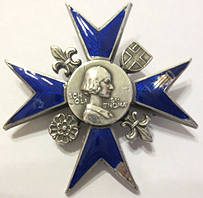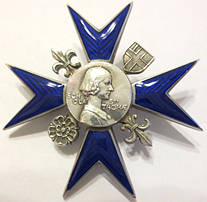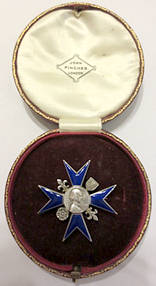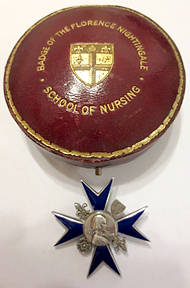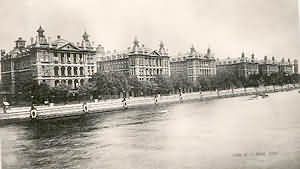|
Collecting Nursing History 40 A tale of three Nightingales Sarah Rogers. |
 |
Please Note: Whilst every care is taken in checking promoted links, we cannot accept responsibility for your use of third party web links. | ||||||||||||
Fig 1 and 2. The condition of these two badges contrasts markedly; the older badge on the right is pristine and still has its own red box; perhaps it was rarely worn? This older badge was awarded to Catherine Ethel McMinn Graham. Catherine entered the nurse training school of St Thomas Hospital on February 27th 1923, aged 25 years old.(1) Her father Dr John Graham was a Missionary with the China Inland Mission; their home address was in Kendal. Catherine had previously worked as a mothers' help/nursery nurse, and paid £5 on entering the Nightingale training home. Catherine qualified on November 19th 1926, her training school certificate was number 957, and dated May 1927, with the comment 'completed her engagement May 25th 1927.' (1) Catherine's name was recorded as a state registered nurse with the General Nursing Council on 19.11.1926, her registration number was 44036.(2) In June 1927 she took a four month course in the VD department at St Thomas', and then worked on 'Mary' and took her Central Midwife Board exams, passing in May 1928.(1) In June 1928 she returned to the VD department, and having worked there for six months left in November 1928. The last entry in her hospital records states that she was a nurse in the King George V Memorial hospital, Malta, which had opened in 1922 at Floriana, in memory of the Merchant Sailors who died in the First World War; in 1942, during the Second World War it was seriously damaged and was rebuilt, eventually closing in 1967.(4)
Fig 3, the badge of Catherine Ethel McMinn Graham. Catherine remained in GNC indexes until at least 1931; further indexes were not searched forwards; she may also have been living in London from 1939 onwards, but as only one middle initial is used in the electoral role records it is difficult to prove.(3) Catherine appears to have died in Worthing in the June registration quarter of 1980, aged 82. By obtaining a copy of her will, if she left one, it may be possible to determine more about her family, and life.
The second
and battered Nightingale was owned by Mary Mildred Pickering and
awarded to her in 1939, after three years training; which was
shortened by one year due to the start of WW2 and shortage of
nurses.
Fig 4; Mary Pickering's badge. Mary was born in Beckenham, in June 1905, and had lived in Leigh-on-Sea, and Bishops Stortford; she entered nurse training in June 1936 aged 30 in the 'ordinary class' but transferred to 'SP', possibly because of her previous three year experience as a medical secretary to a GP. She was promoted to permanent hospital staff in 1937, after one year's training and qualified on September 11th 1939, eleven days after the start of WW2, and was registered as a nurse in January 1940 her GNC registration number was 102505.(13) Her report summary in June 1939 said she was 'Loyal, conscientious, capable and reliable,...She was invariably kind to the patients...' (9) Her Nightingale records document her career; in April 1940, Mary completed her Part 1 Midwifery training at Birmingham Maternity Hospital, and in June 1942, she was appointed Ward Sister at Newton Abbot Hospital but later on in 1942, she is reported to be 'Undertaking Industrial Nursing'. In 1945 she 'Had a serious accident whilst cycling -leg amputated but hopes to return to work.' (9) Presumably because of the accident she worked from 1950-1952 as a 'Nurse secretary' and from 1952-4 as a 'Nurse secretary to a private doctor in Hove'. By 1955, Mary worked for eight months as part time relief sister at Ashbarton hospital, Devon, before retiring due to ill health in 1958. Mary's record is particularly full, and the last entry states; '1967- no further information'. (9) Mary appears to have died aged 85 in March 1991 in Southend-on-Sea.
The third
Nightingale, probably did not have a badge, as she trained in 1883.
Family rumours suggested that Victoria Watson -Taylor, a great great
great-aunt of mine had been a nurse. Censuses for 1901 and 1911 also
supported this, but only said 'hospital nurse'; by 1911 she
is also recorded as 'retired', which along with difficulties
in tracing people with a double surname in censuses, meant that she
proved elusive. It was only recently that I broke down this research
'brick wall'; and I found proof that Victoria had been a nurse. I
found her name in a Burdett's' hospital Directory of nurses for
1899, and saw that she trained at St Thomas'. I was delighted to
find another nurse among my ancestors; I have also recently found
another, more distant relative, who trained at the London Hospital
in Eva Luckes time, so was delighted to find one who trained at St
Thomas' in Florence Nightingales lifetime. Victoria was born in
1860, the youngest of eleven children born to a wealthy family who
lived in Erlestoke Park; a large country mansion once visited by
Queen Victoria, the family's lifestyle dubiously financed by sugar
plantations and the slave trade; the house is now a prison. I only
have one picture of Victoria's sister Rose, my great great
grandmother, despite the rumour that the family were painted by a
society painter, so use a photograph of St Thomas' instead.
Fig 5. St Thomas' Hospital, London Victoria started her preliminary training at the Central Nurses home of the Metropolitan Nurses Association on October 8th 1883, and entered St Thomas's Hospital on 7th November 1883.(14) On 27th November 1883, Victoria entered the Nurse Training school of St Thomas' Hospital, as a paying probationer, and paid £30 for an expedited one-year training; however she did receive three gratuties.(17) Victoria completed her training one year later on 1st November 1884; there is only a brief record of her; the records for the training school are rather patchy over this period and often overlap with different dates being given. Victoria joined the 'N.N.A.' on 31st December 1884 and returned to the Central Home on probation on January 2nd 1885.(15) Victoria worked from the Central Home until 11th October 1886 when she transferred to 'Westminster', but 'Left on account of Health July 1887'.(16) Another St Thomas's hospital record states that she: 'Resigned in 1893 to become a 'District nurse in Chelsea'.(6) The 1891 census describes her as ' hospital nurse and midwife' with a note written beside 'sick', and she is lodging in Westminster, although her family had rented houses in Portland Place and Grosvenor Square, where Victoria and her ten siblings were born.(7) Victoria is described as working for the Metropolitan Nursing Association until 1887, and then in 1898 as a ' parish nurse', for St Matthews Church, Great Peter Street, London. (8) The Metropolitan and National Nursing Association for Providing Nurses for the Sick Poor, was established 'To train and provide skilled nurses, to nurse the sick poor in their own homes.' by Florence Nightingale in 1875.(10) The nurses were also known as Bloomsbury Nurses; the first headquarters to train them was in Bloomsbury Square in 1875.(11) The association became in 1925 the Metropolitan District Nursing Association and it worked alongside the Queens Nursing Institute from 1889, before the QNI succeeded it.(11) Victoria moved to Harrow in the 1920's and lived in the Covent of the Visitation, dying and being buried there in 1939. All three women showed grit and mettle inspired by the founder of their nurse training school, Florence Nightingale. Catherine, followed to an extent in her father's footsteps by working abroad, Mary managed to return to work despite a major injury, at a time when prosthetic limbs were harsh and un-accommodating on the remaining stumps, and Victoria left a safe, upper middle class wealthy back ground, albeit with one sibling who had a well publicised acrimonious divorce, to work among the poor in London as a District Nurse. Postscript: For those of us who have watched the BBC's 'Call the Midwife, and read about the research behind the programme, here is another conundrum; apart from the BBC's general inability to get the London hospital uniform correct! 'Chummy also known as Camilla Cholmeley-Browne ', the author Jennifer Worth's friend is meant to be a real person who trained at St Thomas' and received a Gold Prize; the programme researchers were unable to verify this story, possibly due to name changes and from memory I recall that they said that St Thomas's Hospital Training School had not awarded prizes. When searching among the St Thomas' records recently I found documentary evidence that St Thomas's Nightingale Training School did award Gold, Silver and Bronze medals to student nurses in 1939, based on their success in their exams.(12) Looking for Chummy among the records, would make it rather a 'fishing trip', because of her name change from real life to the book; and the medal prizes may have been stopped by the time ' Chummy' is supposed to be there.
REFERENCES 1. London Metropolitan Archives, H01/ST/NTS/C/03/001, entry 797 2. The National Archives, General Nursing Council Register, DT10/67, Register 11. 3. TNA, DT10/10, GNC Indexes,1931. 4. http://www.oocities.org/hotsprings/2615/medhist/hospital5.htm, accessed 26th December 2013.
5. http://www.nationalarchives.gov.uk/currency/results.asp#mid,
accessed 26th December 2013;
6. L.M.A,
H01/ST/NTS/C/05/003, pg 8; it is thought that NNA is the
Metropolitan and National Nursing Association, also known as the 7. www. Ancestry.co.uk, TNA, 1891 census, Class: RG12; Piece: 63; Folio: 57; Page: 39; GSU Roll: 6095173. 8. Burdett's' hospital directory of nurses 1898, The Royal London Hospital Museum and Archives. 9. L.M.A, H01/ST/NTS/C/04/025, pg 1925.
10.
http://www.cityoflondon.gov.uk/things-to-do/visiting-the-city/archives-and-city-history/london-metropolitan-
11. http://www.ucl.ac.uk/bloomsbury-project/institutions/mnna.htm,
accessed 27th December 2013;
12. L.M.A,
H01/ST/NTS/C/11/002, pg; Final Results and Medal Awards 1939; the
characters names were altered for the book by 13. TNA, GNC Index, DT10/31, 1941. 14. LMA, Roll of Probationer Nurses, CLC/010/MS1650/001, pg 59; LMA, Admissions Register Number 1, A/NFC/017/001, pg 49. 15. LMA, Nominal Roll of Nurses, CLC/010/MS14649,pg's 4, 49. 16. LMA, Nominal Roll of Nurses, CLC/010/MS14649,pg's 4, 49. 17. £30 was worth about £1,500 in 2005; LMA, Admissions Register Number 1, A/NFC/017/001, pg 49. Illustrations; 1-5; Copyright Author. Acknowledgements; With many thanks to all those who provide encouragement and support, in particular to my husband Harry and Will for his seemingly boundless and energy time in getting these articles up on Schools of Nursing. © Sarah Rogers 9/1/2014. |
SECTION
1 SECTION 2 |
|||||||||||||
| Home Schools Region Forum Collecting Galleries History Bibliography News Archive Contact |
